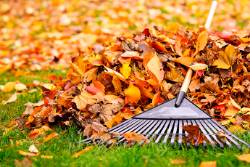Six Focus Areas for Fall Yard Care
September 27, 2018
Ask a Specialist: Six Focus Areas for Fall Yard Care
Fall is in the air, and the leaves are changing. It will soon be time to put the lawn and garden to bed for the year. By investing time before winter takes over, you can ensure healthier and happier plants next spring. Consider these tips.

* After the fall harvest, remove spent plants from the garden. Add non-diseased plants to your compost pile, and throw away any that are diseased. If you do not have a compost pile, haul plants to the local green waste facility.
* Do not leave spent plants in landscape beds. Remove annual flowers such as petunias and marigolds by the root after they are killed by hard frost. Cut perennials back to a few inches above the ground after foliage dies back. As with vegetables, compost spent materials or send them to the green waste facility unless they are diseased.
* If the soil in your garden or landscape beds needs to be improved, as it often does, late fall is the best time to do it. Apply 2 to 3 inches of organic matter such as leaves or compost and till it into the soil. Doing this in the fall allows soil microorganisms many months to break down the compost in preparation for next year’s plantings. Another advantage of applying compost in the fall is that if it is too hot from excessive salts, the salts will generally leach out over the winter and early spring months.
* Continue mowing the lawn until it stops growing. Leaving it extra shaggy in late fall encourages a disease complex called snow mold. Also be sure to rake all leaves and debris from the lawn as another preventative measure. For lawns that receive moderate to heavy traffic, apply a final application of fertilizer in early November. Grass roots absorb nitrogen and other nutrients in preparation for spring.
* Remember that trees and shrubs have different fall requirements than annuals and perennials. Since they are going dormant in the fall, do not fertilize or heavily prune them this time of year. Both encourage new green growth and can seriously delay dormancy. If plants are not completely dormant by the time winter cold arrives, they may suffer severe damage.
* Finally, fall is the time to plant bulbs such as daffodils, tulips and crocus. Shop early for the best selection. Bulbs can play an important part in the design of a well-planned landscape and can brighten early spring days. Of the bulbs, daffodils seem to be the most deer resistant.
By: Taun Beddes, Utah State University Extension horticulturist, (801) 851-8465, Taun.beddes@usu.edu


 Utah 4-H & Youth
Utah 4-H & Youth